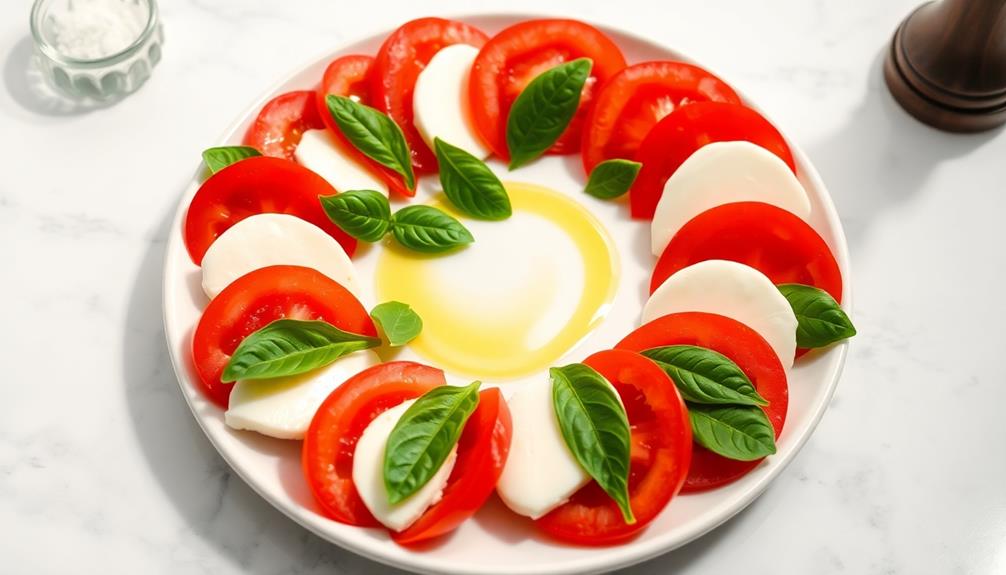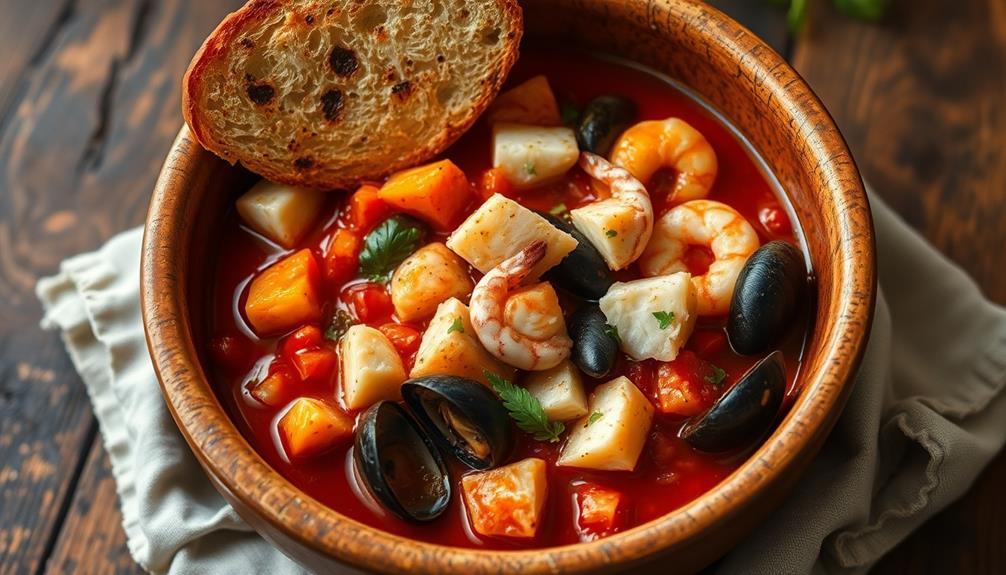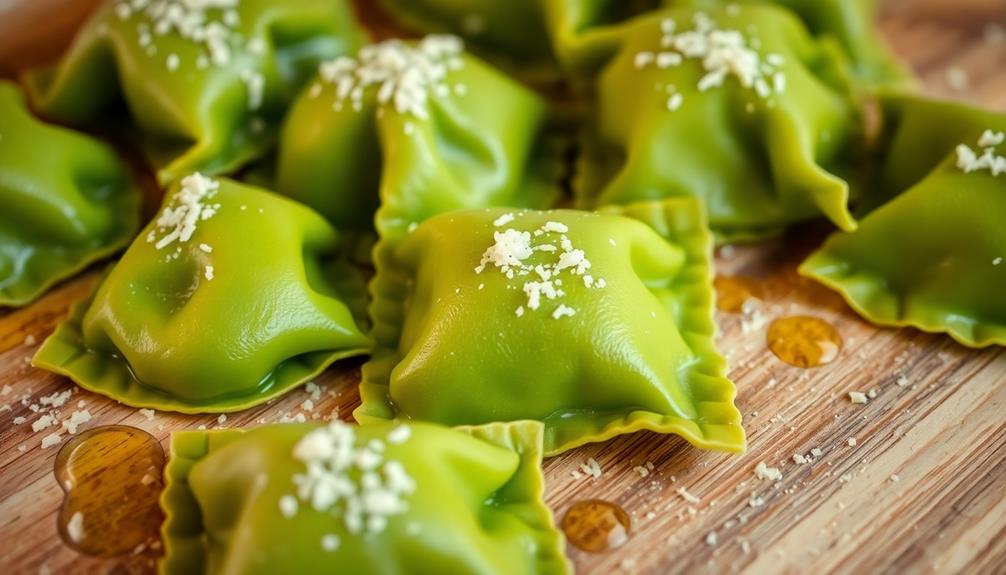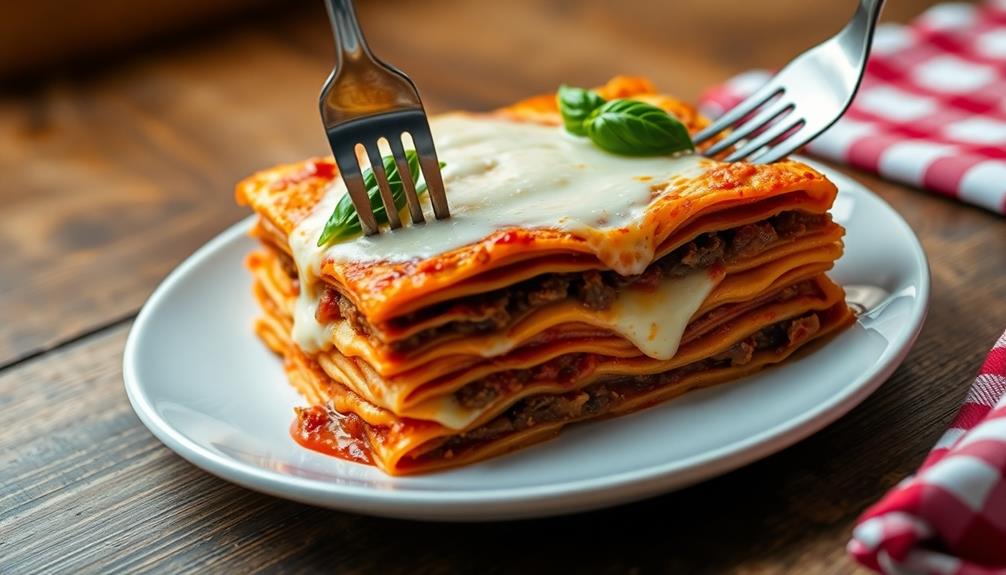Margherita pizza is a delicious Italian classic that you'll love! It's named after Queen Margherita and has a rich history dating back to 1889. You'll need simple ingredients: dough, tomatoes, fresh mozzarella, and basil. To make it, stretch out your dough, add sauce, cheese, and bake until the crust is golden. Don't forget to sprinkle fresh basil on top after baking! It's perfect for family dinners or fun gatherings with friends. The best part? You can easily make it at home for a fraction of the cost. Get ready to taste Italy in every bite! Discover the secrets to making the perfect Margherita pizza.
Key Takeaways
- Margherita pizza originated in Naples, Italy, featuring tomatoes, mozzarella, and basil to represent the Italian flag colors.
- Key ingredients include pizza dough, fresh mozzarella, tomato sauce, basil leaves, and minimal additional toppings.
- The pizza is known for its simple yet flavorful combination, emphasizing high-quality, fresh ingredients.
- Baking typically occurs at high temperatures (around 450°F/230°C) for 10-12 minutes until the crust is golden.
- Margherita pizza is ideal for various occasions, from family dinners to casual gatherings, and can be easily made at home.
History
Tracing its roots back to late 19th century Naples, Italy, the Margherita pizza has become an iconic symbol of Italian cuisine. You'll love learning about its fascinating history!
In 1889, Queen Margherita of Italy visited Naples. During her trip, she was served a special pizza created by chef Raffaele Esposito. He wanted to impress the queen, so he made a pizza that represented the colors of the Italian flag:
- Red: tomatoes
- White: mozzarella cheese
- Green: fresh basil leaves
The queen was delighted by this patriotic pizza, and it soon became known as the "Margherita" in her honor. From that moment on, it spread throughout Italy and eventually around the world. The Margherita pizza’s simple but delicious combination of tomatoes, fresh mozzarella, and basil embodies the colors of the Italian flag, making it a truly patriotic dish. Just like the traditional Italian pasta dish, it has become a staple of Italian cuisine and a favorite of people everywhere. Its popularity continues to grow as more and more pizza lovers savor its classic flavors.
Today, you can find Margherita pizzas in almost every pizzeria. It's a simple yet delicious combination that's perfect for family dinners or festive gatherings.
When you bite into a slice, you're not just enjoying a tasty meal – you're also tasting a piece of Italian history! So next time you order a Margherita pizza, remember its royal origins and savor every bite.
Recipe
Margherita pizza is a classic Italian dish that embodies simplicity and flavor. Originating in Naples, this pizza is known for its fresh ingredients and vibrant colors that represent the Italian flag: red tomatoes, white mozzarella, and green basil.
Creating a perfect Margherita pizza at home is a rewarding experience that allows you to enjoy an authentic taste of Italy. The key to a great Margherita lies in the quality of ingredients and the technique used to prepare the dough and assemble the pizza.
- 3 cups all-purpose flour
- 1 tsp instant yeast
- 1 tsp salt
- 1 cup warm water
- 2 tbsp olive oil
- 1 can (14 oz) San Marzano tomatoes
- 8 oz fresh mozzarella cheese
- Fresh basil leaves
- Extra virgin olive oil for drizzling
To make the pizza, start by preparing the dough. Mix the flour, yeast, and salt in a large bowl. Add warm water and olive oil, then knead until smooth. Let the dough rise for about an hour.
Preheat your oven to its highest setting (usually 500°F or 260°C) with a pizza stone or baking sheet inside. Roll out the dough thinly and transfer it to a pizza peel or another baking sheet lined with parchment paper. Spread a thin layer of crushed tomatoes over the dough, leaving a border for the crust. Tear the mozzarella into pieces and distribute them evenly.
Bake for 8-10 minutes until the crust is golden and the cheese is bubbly. Remove from the oven, add fresh basil leaves, and drizzle with extra virgin olive oil before serving.
For the best results, use high-quality ingredients and allow your dough to rise slowly in the refrigerator overnight for better flavor development. If you don't have a pizza stone, you can use an inverted baking sheet to achieve a crispy crust.
Remember that Margherita pizza is meant to be simple, so resist the urge to add too many toppings. The balance of flavors comes from the quality of each ingredient working in harmony.
Cooking Steps
Get ready to create your perfect Margherita pizza with these simple steps!
You'll start by preparing the pizza dough and tomato sauce, then add fresh mozzarella cheese and basil leaves.
Step 1. Prepare Pizza Dough
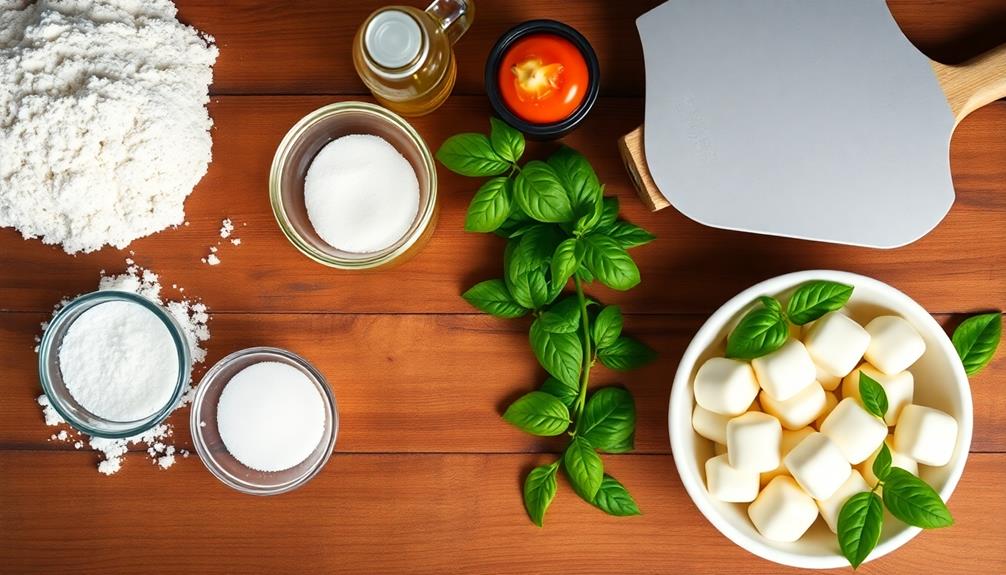
To kickstart your Margherita pizza journey, you'll need to prepare the dough. Don't worry, it's easier than you might think! First, gather your ingredients:
- 3 cups all-purpose flour
- 1 teaspoon salt
- 1 teaspoon sugar
- 2 1/4 teaspoons active dry yeast
- 1 cup warm water
- 2 tablespoons olive oil
In a large bowl, mix the flour, salt, and sugar. Make a well in the center and add the yeast. Pour in the warm water and olive oil. Stir everything together until it forms a shaggy dough.
Now comes the fun part! Knead the dough on a floured surface for about 10 minutes. It'll become smooth and elastic.
Place it in a greased bowl, cover with a damp cloth, and let it rise in a warm spot for an hour.
Once it's doubled in size, punch it down and divide it into two balls. You're now ready to shape your pizza crusts!
Step 2. Prepare Tomato Sauce
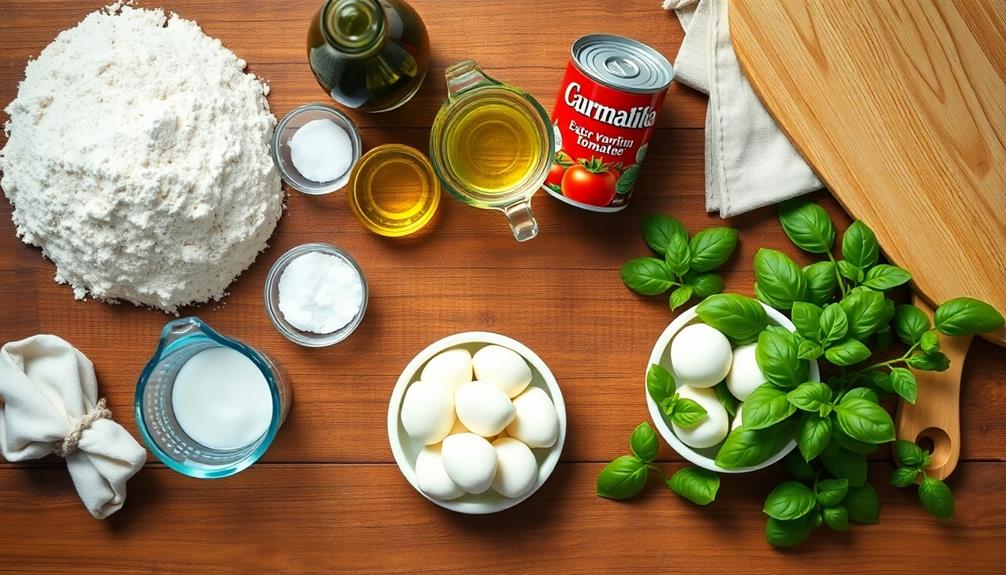
With your pizza dough ready to go, it's time to focus on the sauce. Making your own tomato sauce is easy and fun! Here's how to whip up a delicious sauce for your Margherita pizza:
Ingredients:
- 1 can of whole peeled tomatoes
- 2 cloves of garlic
- 1 tablespoon of olive oil
- Salt and pepper to taste
- A pinch of dried oregano
Steps:
- Open the can of tomatoes and drain the excess liquid.
- In a large bowl, crush the tomatoes with your hands. It's messy, but kids love this part!
- Peel and finely chop the garlic cloves.
- Heat the olive oil in a saucepan over medium heat.
- Add the garlic and cook until it's fragrant, about 1 minute.
- Pour in the crushed tomatoes and stir well.
- Season with salt, pepper, and oregano.
- Simmer the sauce for 15-20 minutes, stirring occasionally.
- Let it cool before spreading on your pizza dough.
Your homemade sauce will smell amazing and taste even better!
It's the perfect base for your Margherita pizza, adding a burst of fresh tomato flavor to every bite.
Step 3. Add Fresh Mozzarella Cheese

Fresh mozzarella is the star of a Margherita pizza, and adding it correctly is crucial. You'll want to use high-quality, fresh mozzarella for the best flavor and texture. Here's how to add it:
- Tear the mozzarella:
- Don't slice it! Tearing creates irregular shapes that melt beautifully.
- Aim for pieces about the size of a cherry tomato.
- Distribute evenly:
- Spread the torn mozzarella across the pizza, leaving some space between pieces.
- Don't overcrowd – less is more with fresh mozzarella.
- Timing is key:
- Add the cheese after the sauce but before baking.
- This allows it to melt perfectly without burning.
Remember, fresh mozzarella contains a lot of moisture. To prevent a soggy pizza:
- Pat the torn pieces gently with a paper towel before adding them.
- Let the cheese come to room temperature for about 30 minutes before use.
Step 4. Add Fresh Basil Leaves

Basil leaves are the crowning glory of a Margherita pizza, adding a burst of freshness and aroma. To add this final touch:
- Wait until your pizza is out of the oven and cooled for 1-2 minutes.
- Wash and dry fresh basil leaves gently.
- Pick leaves that are bright green and unblemished.
- Tear larger leaves into smaller pieces by hand.
- Sprinkle the basil evenly over the pizza's surface.
Don't be shy with the basil! It's a key flavor in Margherita pizza. You'll want enough to get some in every bite. The heat from the pizza will slightly wilt the leaves, releasing their wonderful scent.
For a fun family pizza night, try these ideas:
- Let kids place their own basil leaves.
- Make a game of counting how many leaves you use.
- Experiment with different basil varieties, like Thai or lemon basil.
Step 5. Bake in Hot Oven
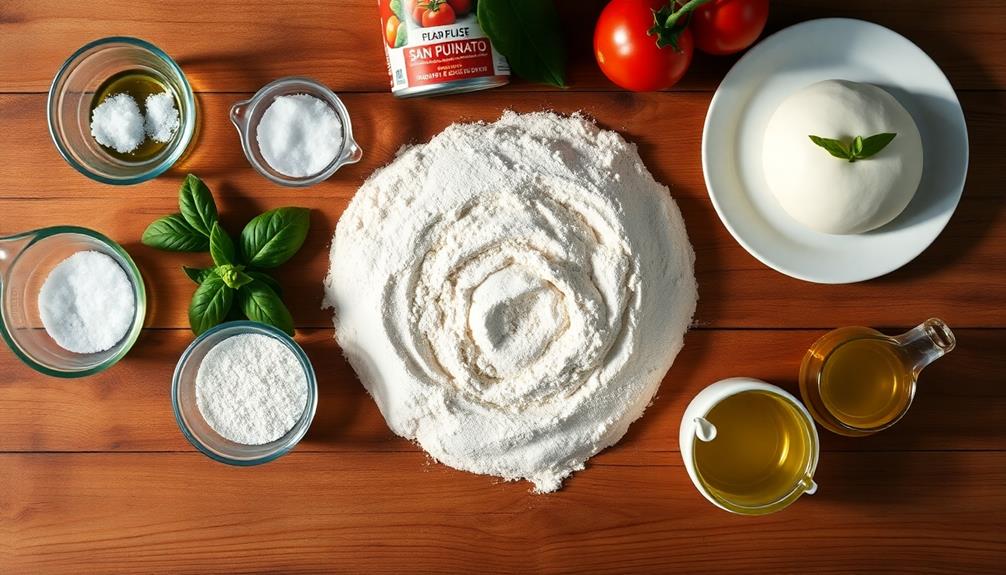
Baking your Margherita pizza in a hot oven is crucial for achieving that perfect crispy crust and melted cheese. Here's how to do it:
- Preheat your oven to 450°F (230°C). This high temperature will help create that authentic pizzeria-style crust.
- Place your pizza stone or baking sheet in the oven while it's heating up. This will ensure a crispy bottom crust.
- When the oven is ready, carefully slide your prepared pizza onto the hot stone or sheet.
- Bake for 10-12 minutes, or until the crust is golden brown and the cheese is bubbly and slightly browned.
- Keep an eye on your pizza as it bakes. Every oven is different, so you might need to adjust the time slightly.
- Once it's done, remove the pizza from the oven using a pizza peel or spatula.
Let your Margherita pizza cool for a minute or two before slicing. This will help the cheese set and make it easier to cut.
Now, gather your family around and enjoy your delicious homemade pizza together!
Final Thoughts
Three key elements make Margherita pizza a timeless classic: simplicity, quality ingredients, and perfect execution. You've now mastered the art of creating this delicious Italian favorite!
Remember, the beauty of Margherita pizza lies in its uncomplicated nature. Here are some final thoughts to keep in mind:
- Always use fresh, high-quality ingredients
- Don't overload the pizza with toppings
- Let the flavors of basil, mozzarella, and tomatoes shine
Margherita pizza is perfect for:
- Family dinners
- Casual get-togethers with friends
- Festive occasions
You'll find that making Margherita pizza becomes easier with practice. Soon, you'll be able to whip up this crowd-pleaser in no time!
Don't be afraid to experiment a little, but stay true to the pizza's core elements. The joy of sharing a homemade Margherita pizza with loved ones is unmatched.
It's a fun activity that brings everyone together in the kitchen and around the table. So, fire up that oven, gather your ingredients, and get ready to create some delicious memories with your very own Margherita pizza!
Frequently Asked Questions
Is Margherita Pizza Healthier Than Other Pizza Types?
You'll find margherita pizza is generally healthier than many other types. It's simpler, with fewer toppings and less cheese. You're getting fresh ingredients like tomatoes and basil, which provide nutrients without excessive calories or fat.
Can Margherita Pizza Be Made Without Cheese for Vegans?
You can definitely make a vegan version of this pizza without cheese. Simply omit the mozzarella and use a plant-based alternative if desired. The classic tomato sauce and basil toppings are already vegan-friendly, so you're good to go!
What Wine Pairs Best With Margherita Pizza?
You'll find a light, crisp Italian red wine pairs wonderfully with this dish. Try a Chianti or Sangiovese. If you prefer white, go for a dry Pinot Grigio. Don't forget to enjoy responsibly!
How Long Does Leftover Margherita Pizza Stay Fresh in the Refrigerator?
You'll want to eat your leftover pizza within 3-4 days for the best quality. Store it in an airtight container or wrap it tightly in aluminum foil. Don't leave it out at room temperature for more than 2 hours.
Are There Regional Variations of Margherita Pizza Outside of Italy?
You'll find regional variations of this classic pizza beyond Italy. In the U.S., you might encounter thicker crusts or extra toppings. Some places use different cheeses or add garlic. Even the tomato sauce can vary slightly.



